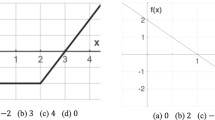Abstract
This study furthers the theory of conceptual blending as a useful tool for revealing the structure and process of student reasoning in relation to the Sierpinski triangle (ST). We use conceptual blending to investigate students’ reasoning, revealing how students engage with the ST and coordinate their understandings of its area and perimeter. Our analysis of ten individual interviews with mathematics education masters’ student documents diverse ways in which students reason about this situation through the constituent processes of blending: composition, completion, and elaboration. This reveals that students who share basic understandings of the area and perimeter of the ST recruit idiosyncratic ideas to engage with and resolve the paradox of a figure with infinite perimeter and zero area.



Similar content being viewed by others
References
Alexander, J. C. (2011). Blending in mathematics. Semiotica, 2011(187), 1–48.
Apkarian, N., Rasmussen, C., Tabach, M., & Dreyfus, T. (2018). Conceptual blending: The case of the Sierpinski triangle area and perimeter. In A. Weinberg, C. Rasmussen, J. Rabin, M. Wawro, & S. Brown (Eds.), Proceedings of the 21st Annual Conference on Research in Undergraduate Mathematics Education (pp. 541–548). San Diego, CA.
Dubinsky, E., Weller, K., McDonald, M. A., & Brown, A. (2005). Some historical issues and paradoxes regarding the concept of infinity: An APOS-based analysis: Parts 1&2. Educational Studies in Mathematics, 58, 335–359 60, 253–266.
Edwards, L. D. (2009). Gestures and conceptual integration in mathematical talk. Educational Studies in Mathematics, 70, 127–141.
Ely, R. (2011). Envisioning the infinite by projecting finite properties. Journal of Mathematical Behavior, 30, 1–18.
Fauconnier, G., & Turner, M. (2002). The way we think. New York: Basic Books.
Gerson, H. & Walter, J. (2008). How blending illuminates understandings of calculus. In Electronic Proceedings for the Eleventh Special Interest Group of the Mathematical Association of America on Research in Undergraduate Mathematics. Retrieved from http://rume.org/crume2008/Proceedings/Gerson%20LONG.pdf. Accessed 13 June 2017.
Jordan, B., & Henderson, A. (1995). Interaction analysis: Foundations and practice. The Journal of the Learning Sciences, 4(1), 39–103.
Lakoff, G., & Núñez, R. (2000). Where mathematics comes from: How the embodied mind brings mathematics into being. New York: Basic Books.
Larsen, S., Marrongelle, K., Bressoud, D., & Graham, K. (2017). Understanding the concepts of calculus: Frameworks and roadmaps emerging from educational research. In J. Cai (Ed.), Compendium for Research in Mathematics Education (pp. 526–550). National Council of Teachers of Mathematics.
Mamolo, A., & Zazkis, R. (2008). Paradoxes as a window to infinity. Research in Mathematics Education, 10(2), 167–182.
Núñez, R. (2005). Creating mathematical infinities: Metaphor, blending, and the beauty of transfinite cardinals. Journal of Pragmatics, 37(10), 1717–1741.
Radu, I., & Weber, K. (2011). Refinements in mathematics undergraduate students’ reasoning on completed infinite iterative processes. Educational Studies in Mathematics, 78, 165–180.
Rasmussen, C., Apkarian, N., Tabach, M., & Dreyfus, T. (in review). Ways in which engaging in someone else’s reasoning is productive.
Rasmussen, C., & Wawro, M. (2017). Post-calculus research in undergraduate mathematics education. In J. Cai (Ed.), Compendium for research in mathematics education (pp. 551–581). Reston, VA: National Council of Teachers of Mathematics.
Sacristán, A. I. (2001). Students’ shifting conceptions of the infinite through computer explorations of fractals and other visual models. In M. van den Heuvel-Panhuizen (Ed.), Proceedings of the 25th International Conference for the Psychology of Mathematics Education (Vol. 4, pp. 129–136). Utrecht, The Netherland: PME.
Strauss, A., & Corbin, J. (1998). Basics of qualitative research: Techniques and procedures for developing grounded theory (2nd ed.). Thousand Oaks, CA: Sage.
Tabach, M., Apkarian, N., Dreyfus, T., & Rasmussen, C. (2017). Can a region have no area but infinite perimeter? In B. Kaur, W. K. Ho, T. L. Toh, & B. H. Choy (Eds.), Proceedings of the 41st Conference of the International Group for the Psychology of Mathematics Education (Vol. 4, pp. 241–248). Singapore: PME.
Wijeratne, C., & Zazkis, R. (2015). On painter’s paradox: Contextual and mathematical approaches to infinity. International Journal of Research in Undergraduate Mathematics Education, 1, 163–186.
Yoon, C., Thomas, M. O. J., & Dreyfus, T. (2011). Grounded blends and mathematical gesture spaces: Developing mathematical understandings via gestures. Educational Studies in Mathematics, 78, 371–393.
Zandieh, M., Roh, K. H., & Knapp, J. (2014). Conceptual blending: Student reasoning when proving “conditional implies conditional” statements. Journal of Mathematical Behavior, 33, 209–229.
Funding
This research was supported by the Israel Science Foundation grant no. 438/15.
Author information
Authors and Affiliations
Corresponding author
Additional information
Publisher’s note
Springer Nature remains neutral with regard to jurisdictional claims in published maps and institutional affiliations.
Rights and permissions
About this article
Cite this article
Apkarian, N., Tabach, M., Dreyfus, T. et al. The Sierpinski smoothie: blending area and perimeter. Educ Stud Math 101, 19–34 (2019). https://doi.org/10.1007/s10649-019-09889-4
Published:
Issue Date:
DOI: https://doi.org/10.1007/s10649-019-09889-4




